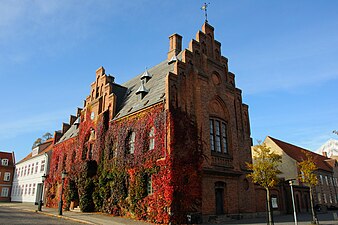Vilhelm Tvede

Frederik Vilhelm Tvede (13 May 1826 – 27 November 1891) was a Danish architect.[1]
Biography
Tvede was born in the parish of Trinitatis in Copenhagen, Denmark. He was the son of Johan Frederik Tvede and Christine f. Norup.
He was a student of Gustav Friedrich Hetsch at the
Royal Danish Academy of Fine Arts. He was employed as a drawing teacher at the Technical Institute (Teknologisk Institut) and worked for Det Classenske Fideicommis. His son, Gotfred Tvede was also an architect associated with Det Classenske Fideicommis.
[2][3]
Among other projects, Tvede led the restoration of the Church of Our Lady (Vor Frue Kirke) at Kalundborg (1867-1871) as well as Goose Tower (Gåsetårnet) at Vordingborg Castle (1871). He designed Humlebæk Church (1868) and Vedbæk Church (1870-1871). He was also responsible for the first architect-designed fisherman's cottage in Denmark in the village of Hesnæs; the roofing was later changed by his son in 1919. [4] [5]
Personal life
In 1857, he married Marie Ostermann. He was the father of architect Gotfred Tvede (1863-1947). In 1871 he became Knight of the Order of Dannebrog. He died during 1891 and was buried at Assistens Cemetery in Copenhagen.
Gallery
-
Humlebæk church (Fredensborg)
-
Andersen’s Water Tower, (Frederiksberg)
-
Old Police Station (Sorø)
-
Vedbæk Church (Copenhagen)
References
- ^ "Vilhelm Tvede". Kunstindeks Danmark & Weilbach Kunstnerleksikon. Retrieved January 1, 2019.
- ^ "Det Classenske Fideicommis". Det Classenske Fideicommis. Retrieved January 1, 2019.
- ^ "Gotfred Tvede". Kunstindeks Danmark & Weilbach Kunstnerleksikon. Retrieved January 1, 2019.
- ^ "Hesnæs". Kulturarv.dk. Retrieved 15 June 2014.
- ^ "Nyborg Vor Frue Kirke". Nyborg Vor Frue Kirke. Retrieved January 1, 2019.
External links
- Vilhelm Tvede entry in the Den Store Danske Encyklopædi (in Danish)




